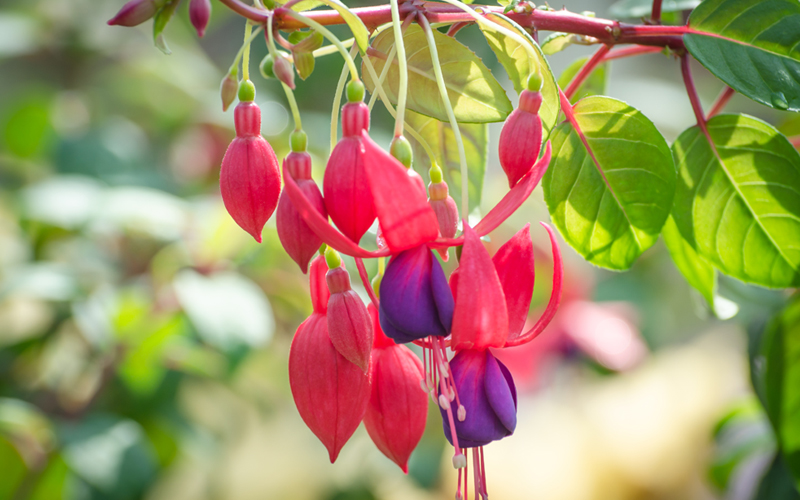
Originating in Central and South America, Fuchsia plants are perennials that produce beautiful, exotic flowers. They are grown throughout the United States and are commonly seen draping out of pots or hanging baskets.
There are over 100 varieties of Fuchsia available, varying in color and appearance. Upright Fuchsia plants are bush-like and are commonly seen in gardens or flower pots. Trailing Fuchsia grow more horizontally and are frequently seen in flower pots or hanging baskets.
Fuchsia plants are considered easy to grow for novice and seasoned gardeners alike. By following the tips below, your Fuchsia plants will produce beautiful flowers throughout the growing season.
Fuchsia plants can be grown from seeds or clippings, but are most commonly sold as established plants. Depending on the variety, plants will begin to produce flowers in early to mid Spring and continue to bloom into early Fall. In general, Fuchsia plants require constant moist soil and partial sun. They will not thrive and may even die if they are over watered or exposed to direct sunlight.
Fuchsia plants respond well to pruning early in the growing season before the plants begin to grow. Flowers will only appear on new growth, so trimming old branches encourages new branches and flowers to appear. Dead and overlapping branches should be cut. Fuchsia plants can also be pruned into the desired shape. Once new growth starts, new buds can be pruned to encourage branch and flower growth. Once Fuchsia plants are blooming, dead flowers should be regularly removed to cause new flowers to appear.

Water requirements
Fuchsia plants require moist soil to thrive. Fuchsia grown in containers should be planted in high quality, well-drained potting soil. Potted Fuchsia will likely require daily watering, but the best way to determine if they need watering is to stick a finger into the soil and make sure that it is damp. Potted Fuchsia will not thrive if the soil is left dry or if it is overly wet; if the soil is too wet, the roots may rot, killing the Fuchsia plant.
Fuchsia planted in gardens, once established, requires slightly less maintenance than potted Fuchsia. Garden Fuchsia should be planted in loose, well-drained soil. Plants will grow best if the soil is moist, but in a garden, they can tolerate a dry day better than potted plants.
Fuchsia should be regularly fertilized. Using a liquid fertilizer once every couple of weeks will allow Fuchsia plants to thrive and produce flowers throughout the growing season.
Sunlight requirements
Fuchsia plants do not grow well direct sunlight or excessive heat. For the best results, Fuchsia should be planted in areas that get partial sunlight. The temperature requirements may vary between varieties of Fuchsia, but as a general rule of thumb, Fuchsia plants grow best if the soil is cool and they are shielded from the hottest hours of sunlight. Plants that receive too much sunlight will lose their flowers quickly and wilt.
:strip_icc()/black-pink-fuchsia-d9379e68-841058e2c73247958d854e89c7252478.jpg)
List of Common Problems That Fuchsia plants have and Solutions
The most common problems when growing Fuchsia are over watering or keeping the plants in areas that receive too much sunlight. However, Fuchsia plants can also attract insects. Outdoors, it is less common for these pests to appear on Fuchsia plants because they receive regular rain and good ventilation. Indoor plants or plants that aren’t well ventilated are prone to aphid or whitefly infestation. If these pests appear, a pesticide should be applied.
Overwintering Fuchsia plants
Fuchsia plants are often treated as annuals and are discarded at the end of the growing season. However, they are actually a perennial plant which can produce flowers for many years is properly cared for during the winter. Most Fuchsia plants will not survive if exposed to cold winter temperatures. However, there are some varieties that can withstand colder temperatures.
Fuchsia plants should be brought indoors during winter and then put into dormancy until the next year. Plants should be sprayed with water to remove any pests that are present, since pests may damage the plants during indoor winter storing. Plants should be placed in a cool, dark location such as a basement or garage. The temperature should be kept at around 50 degrees Fahrenheit. Plants should be watered every 3-4 weeks to keep the soil moist.
During this time, the plants enter a dormant state and will not flower. About a month before the expected last frost of the year, trim Fuchsia plant branches to about half of their length, and then place plants in a well lit area, away from direct sunlight. After the last frost, Fuchsia plants can be moved outside and grown according to the tips above.




 ?. ts.dhung.
?. ts.dhung.
